Zhaowei Zhu
Better Reasoning with Less Data: Enhancing VLMs Through Unified Modality Scoring
Jun 10, 2025Abstract:The application of visual instruction tuning and other post-training techniques has significantly enhanced the capabilities of Large Language Models (LLMs) in visual understanding, enriching Vision-Language Models (VLMs) with more comprehensive visual language datasets. However, the effectiveness of VLMs is highly dependent on large-scale, high-quality datasets that ensure precise recognition and accurate reasoning. Two key challenges hinder progress: (1) noisy alignments between images and the corresponding text, which leads to misinterpretation, and (2) ambiguous or misleading text, which obscures visual content. To address these challenges, we propose SCALE (Single modality data quality and Cross modality Alignment Evaluation), a novel quality-driven data selection pipeline for VLM instruction tuning datasets. Specifically, SCALE integrates a cross-modality assessment framework that first assigns each data entry to its appropriate vision-language task, generates general and task-specific captions (covering scenes, objects, style, etc.), and evaluates the alignment, clarity, task rarity, text coherence, and image clarity of each entry based on the generated captions. We reveal that: (1) current unimodal quality assessment methods evaluate one modality while overlooking the rest, which can underestimate samples essential for specific tasks and discard the lower-quality instances that help build model robustness; and (2) appropriately generated image captions provide an efficient way to transfer the image-text multimodal task into a unified text modality.
Evaluating LLM-corrupted Crowdsourcing Data Without Ground Truth
Jun 08, 2025Abstract:The recent success of generative AI highlights the crucial role of high-quality human feedback in building trustworthy AI systems. However, the increasing use of large language models (LLMs) by crowdsourcing workers poses a significant challenge: datasets intended to reflect human input may be compromised by LLM-generated responses. Existing LLM detection approaches often rely on high-dimension training data such as text, making them unsuitable for annotation tasks like multiple-choice labeling. In this work, we investigate the potential of peer prediction -- a mechanism that evaluates the information within workers' responses without using ground truth -- to mitigate LLM-assisted cheating in crowdsourcing with a focus on annotation tasks. Our approach quantifies the correlations between worker answers while conditioning on (a subset of) LLM-generated labels available to the requester. Building on prior research, we propose a training-free scoring mechanism with theoretical guarantees under a crowdsourcing model that accounts for LLM collusion. We establish conditions under which our method is effective and empirically demonstrate its robustness in detecting low-effort cheating on real-world crowdsourcing datasets.
GUARD: Generation-time LLM Unlearning via Adaptive Restriction and Detection
May 19, 2025Abstract:Large Language Models (LLMs) have demonstrated strong capabilities in memorizing vast amounts of knowledge across diverse domains. However, the ability to selectively forget specific knowledge is critical for ensuring the safety and compliance of deployed models. Existing unlearning efforts typically fine-tune the model with resources such as forget data, retain data, and a calibration model. These additional gradient steps blur the decision boundary between forget and retain knowledge, making unlearning often at the expense of overall performance. To avoid the negative impact of fine-tuning, it would be better to unlearn solely at inference time by safely guarding the model against generating responses related to the forget target, without destroying the fluency of text generation. In this work, we propose Generation-time Unlearning via Adaptive Restriction and Detection (GUARD), a framework that enables dynamic unlearning during LLM generation. Specifically, we first employ a prompt classifier to detect unlearning targets and extract the corresponding forbidden token. We then dynamically penalize and filter candidate tokens during generation using a combination of token matching and semantic matching, effectively preventing the model from leaking the forgotten content. Experimental results on copyright content unlearning tasks over the Harry Potter dataset and the MUSE benchmark, as well as entity unlearning tasks on the TOFU dataset, demonstrate that GUARD achieves strong forget quality across various tasks while causing almost no degradation to the LLM's general capabilities, striking an excellent trade-off between forgetting and utility.
Token Cleaning: Fine-Grained Data Selection for LLM Supervised Fine-Tuning
Feb 04, 2025



Abstract:Recent studies show that in supervised fine-tuning (SFT) of large language models (LLMs), data quality matters more than quantity. While most data cleaning methods concentrate on filtering entire samples, the quality of individual tokens within a sample can vary significantly. After pre-training, even in high-quality samples, patterns or phrases that are not task-related can be redundant or uninformative. Continuing to fine-tune on these patterns may offer limited benefit and even degrade downstream task performance. In this paper, we investigate token quality from a noisy-label perspective and propose a generic token cleaning pipeline for SFT tasks. Our method filters out uninformative tokens while preserving those carrying key task-specific information. Specifically, we first evaluate token quality by examining the influence of model updates on each token, then apply a threshold-based separation. The token influence can be measured in a single pass with a fixed reference model or iteratively with self-evolving reference models. The benefits and limitations of both methods are analyzed theoretically by error upper bounds. Extensive experiments show that our framework consistently improves performance across multiple downstream tasks.
Noise-Resilient Point-wise Anomaly Detection in Time Series Using Weak Segment Labels
Jan 21, 2025



Abstract:Detecting anomalies in temporal data has gained significant attention across various real-world applications, aiming to identify unusual events and mitigate potential hazards. In practice, situations often involve a mix of segment-level labels (detected abnormal events with segments of time points) and unlabeled data (undetected events), while the ideal algorithmic outcome should be point-level predictions. Therefore, the huge label information gap between training data and targets makes the task challenging. In this study, we formulate the above imperfect information as noisy labels and propose NRdetector, a noise-resilient framework that incorporates confidence-based sample selection, robust segment-level learning, and data-centric point-level detection for multivariate time series anomaly detection. Particularly, to bridge the information gap between noisy segment-level labels and missing point-level labels, we develop a novel loss function that can effectively mitigate the label noise and consider the temporal features. It encourages the smoothness of consecutive points and the separability of points from segments with different labels. Extensive experiments on real-world multivariate time series datasets with 11 different evaluation metrics demonstrate that NRdetector consistently achieves robust results across multiple real-world datasets, outperforming various baselines adapted to operate in our setting.
Reassessing Layer Pruning in LLMs: New Insights and Methods
Nov 23, 2024
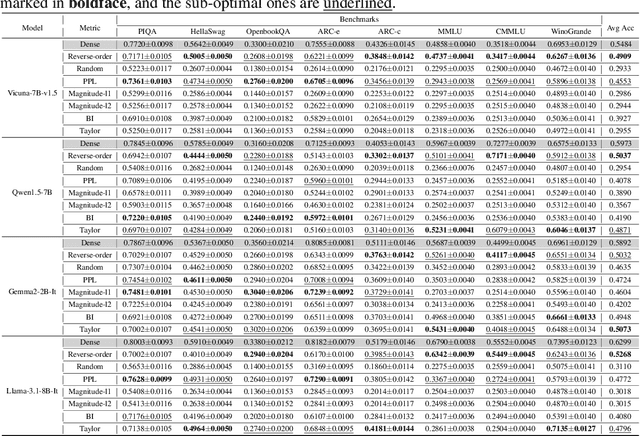
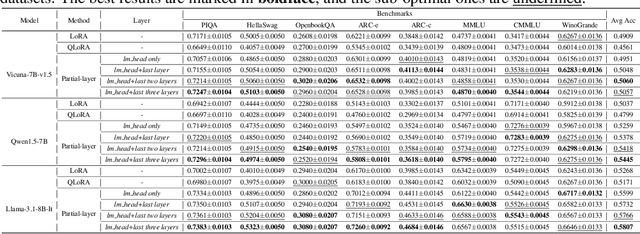

Abstract:Although large language models (LLMs) have achieved remarkable success across various domains, their considerable scale necessitates substantial computational resources, posing significant challenges for deployment in resource-constrained environments. Layer pruning, as a simple yet effective compression method, removes layers of a model directly, reducing computational overhead. However, what are the best practices for layer pruning in LLMs? Are sophisticated layer selection metrics truly effective? Does the LoRA (Low-Rank Approximation) family, widely regarded as a leading method for pruned model fine-tuning, truly meet expectations when applied to post-pruning fine-tuning? To answer these questions, we dedicate thousands of GPU hours to benchmarking layer pruning in LLMs and gaining insights across multiple dimensions. Our results demonstrate that a simple approach, i.e., pruning the final 25\% of layers followed by fine-tuning the \texttt{lm\_head} and the remaining last three layer, yields remarkably strong performance. Following this guide, we prune Llama-3.1-8B-It and obtain a model that outperforms many popular LLMs of similar size, such as ChatGLM2-6B, Vicuna-7B-v1.5, Qwen1.5-7B and Baichuan2-7B. We release the optimal model weights on Huggingface, and the code is available on GitHub.
Improving Data Efficiency via Curating LLM-Driven Rating Systems
Oct 09, 2024
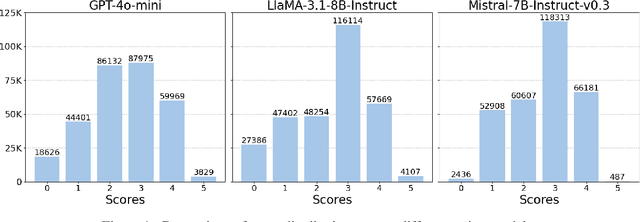


Abstract:Instruction tuning is critical for adapting large language models (LLMs) to downstream tasks, and recent studies have demonstrated that small amounts of human-curated data can outperform larger datasets, challenging traditional data scaling laws. While LLM-based data quality rating systems offer a cost-effective alternative to human annotation, they often suffer from inaccuracies and biases, even in powerful models like GPT-4. In this work, we introduce DS2, a Diversity-aware Score curation method for Data Selection. By systematically modeling error patterns through a score transition matrix, DS2 corrects LLM-based scores and promotes diversity in the selected data samples. Our approach shows that a curated subset (just 3.3% of the original dataset) outperforms full-scale datasets (300k samples) across various machine-alignment benchmarks, and matches or surpasses human-aligned datasets such as LIMA with the same sample size (1k samples). These findings challenge conventional data scaling assumptions, highlighting that redundant, low-quality samples can degrade performance and reaffirming that "more can be less."
Label Smoothing Improves Machine Unlearning
Jun 11, 2024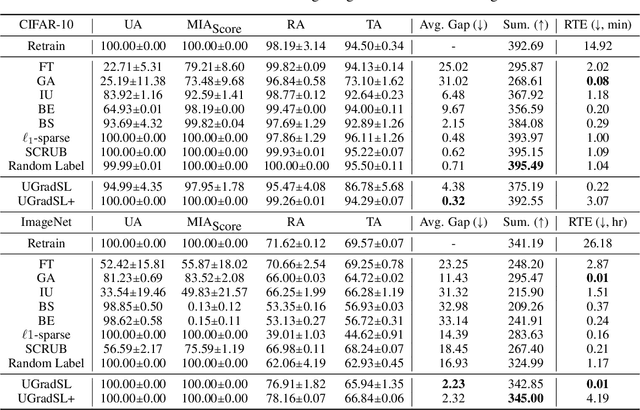

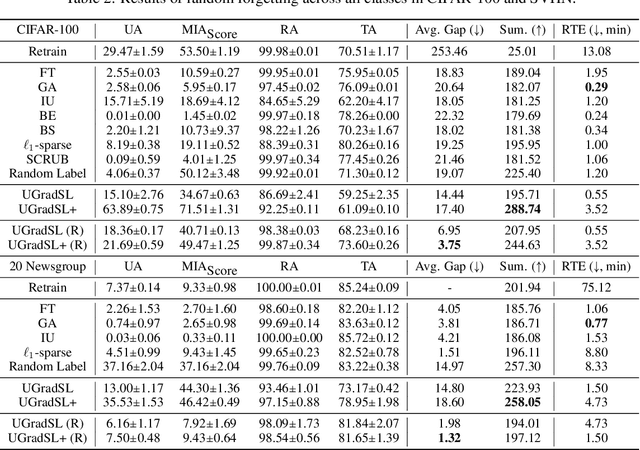

Abstract:The objective of machine unlearning (MU) is to eliminate previously learned data from a model. However, it is challenging to strike a balance between computation cost and performance when using existing MU techniques. Taking inspiration from the influence of label smoothing on model confidence and differential privacy, we propose a simple gradient-based MU approach that uses an inverse process of label smoothing. This work introduces UGradSL, a simple, plug-and-play MU approach that uses smoothed labels. We provide theoretical analyses demonstrating why properly introducing label smoothing improves MU performance. We conducted extensive experiments on six datasets of various sizes and different modalities, demonstrating the effectiveness and robustness of our proposed method. The consistent improvement in MU performance is only at a marginal cost of additional computations. For instance, UGradSL improves over the gradient ascent MU baseline by 66% unlearning accuracy without sacrificing unlearning efficiency.
FedFixer: Mitigating Heterogeneous Label Noise in Federated Learning
Mar 25, 2024Abstract:Federated Learning (FL) heavily depends on label quality for its performance. However, the label distribution among individual clients is always both noisy and heterogeneous. The high loss incurred by client-specific samples in heterogeneous label noise poses challenges for distinguishing between client-specific and noisy label samples, impacting the effectiveness of existing label noise learning approaches. To tackle this issue, we propose FedFixer, where the personalized model is introduced to cooperate with the global model to effectively select clean client-specific samples. In the dual models, updating the personalized model solely at a local level can lead to overfitting on noisy data due to limited samples, consequently affecting both the local and global models' performance. To mitigate overfitting, we address this concern from two perspectives. Firstly, we employ a confidence regularizer to alleviate the impact of unconfident predictions caused by label noise. Secondly, a distance regularizer is implemented to constrain the disparity between the personalized and global models. We validate the effectiveness of FedFixer through extensive experiments on benchmark datasets. The results demonstrate that FedFixer can perform well in filtering noisy label samples on different clients, especially in highly heterogeneous label noise scenarios.
Fair Classifiers Without Fair Training: An Influence-Guided Data Sampling Approach
Feb 20, 2024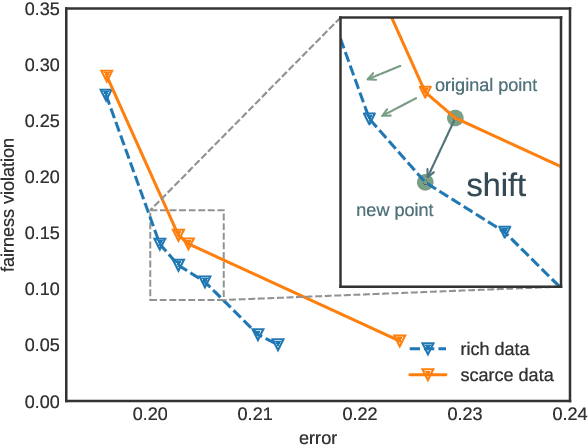
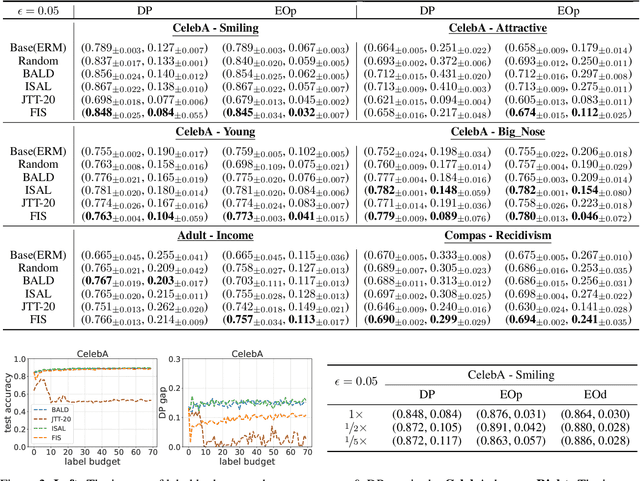
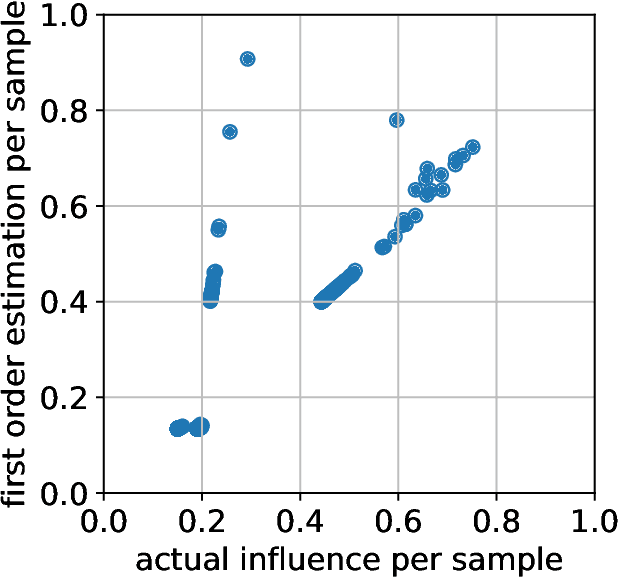
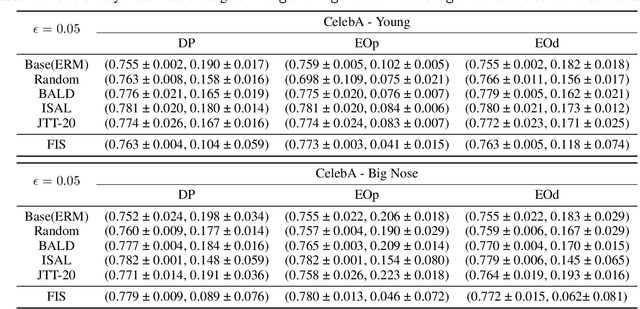
Abstract:A fair classifier should ensure the benefit of people from different groups, while the group information is often sensitive and unsuitable for model training. Therefore, learning a fair classifier but excluding sensitive attributes in the training dataset is important. In this paper, we study learning fair classifiers without implementing fair training algorithms to avoid possible leakage of sensitive information. Our theoretical analyses validate the possibility of this approach, that traditional training on a dataset with an appropriate distribution shift can reduce both the upper bound for fairness disparity and model generalization error, indicating that fairness and accuracy can be improved simultaneously with simply traditional training. We then propose a tractable solution to progressively shift the original training data during training by sampling influential data, where the sensitive attribute of new data is not accessed in sampling or used in training. Extensive experiments on real-world data demonstrate the effectiveness of our proposed algorithm.
 Add to Chrome
Add to Chrome Add to Firefox
Add to Firefox Add to Edge
Add to Edge